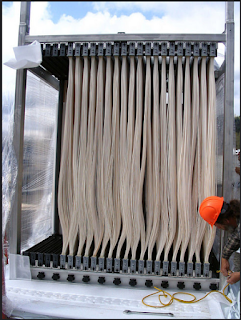A new reclaimed water permit is a reminder to use the right water for the right use
All water on earth is recycled, thanks to nature. Several sewage treatment plants in Washington are using their own process, instead of nature’s, to produce high-quality reclaimed water suitable for local use. Although reclaimed water has been around in Washington for more than 20 years, Ecology issued the state’s first administrative rule last year — the Reclaimed Water Rule (WAC 173-219). All new and reissued permits now follow our new requirements.
Many facilities are using reclaimed water to meet community water needs
In late December 2018, we reissued a permit under the new rule to the Holmes Harbor Sewer District. This small facility outside of Freeland on Whidbey Island exclusively produces reclaimed water to use for irrigation of the Holmes Harbor Golf Course. During the winter, when the golf course does not need the water, the facility stores the reclaimed water in large lagoons until the summer.
We currently have 29 facilities across the state producing reclaimed water (see map below) for a variety of irrigation uses, groundwater recharge, and other environmental benefits such as wetland enhancement. Over the next year we will work on renewing the permits for more than half of those facilities. Also, several other communities across the state are looking at adding reclaimed water as one of their tools meet their long-term water needs.
Reclaimed Water Rule first anniversary
After an extensive public process that started in 2006, we finalized the Reclaimed Water Rule in early 2018. This collaborative effort with the State Department of Health (Health) relied on many important partners across the state, including existing reclaimed water producers, tribal representatives, water utility representatives, consultants from engineering and other technical areas, and interested residents. After finalizing the rule, we worked with many of the same partners to complete our guidance manual for reclaimed water facilities — a document we call the Purple Book.
We work with Heath to protect public health and the environment as we implement the new rule. We work together in reviewing proposals for new reclaimed water projects and in the development of permits for new and existing facilities. Safeguards in the new rule and in the reclaimed water permits are designed to match the water quality requirements with the planned uses. This ensures that water used in public areas is safe for public contact, while allowing use of lower quality water in areas with restricted access. The safeguards also protect drinking water sources by preventing cross-connections for reclaimed water to mix with drinking water supplies.
How is reclaimed water treated so it is safe?
Modern sewage treatment plants do a good job at removing most of the stuff people flush down a toilet or send to a sewer system. They typically remove more than 85% of the solids and biodegradable pollutants that enter the facility and disinfect the water to kill most pathogens. While the treated wastewater is generally safe to discharge and meets appropriate water quality standards, it is not necessarily safe to reuse, especially in areas with direct public contact.
Reclaimed water facilities take the treated domestic wastewater and apply higher levels of treatment to remove more solids and destroy more pathogens. The highest class of reclaimed water — Class A — is processed through filtration systems to remove nearly all solids and disinfected to a level that removes 99.99% of the viruses that may be in treated domestic wastewater. The high level of treatment is enough to turn what was once a wastewater into something that is no longer a waste — it is now a valuable resource ready for a beneficial use.
Brightwater Treatment Plant uses a process called a
Membrane Bioreactor or MBR to produce
Class A reclaimed water.
By using the right water for the right use, reclaimed water is one way that Washington can help preserve water supplies. If you are interested in receiving updates on reclaimed water in Washington, sign up for our listserv.
Visit King County’s reclaimed water website for more information on their facilities.




